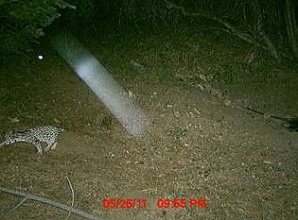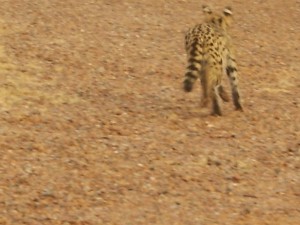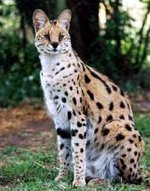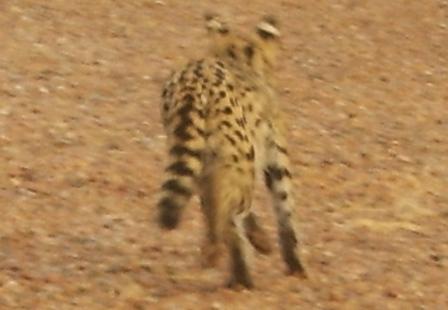Arizona Ocelot Is Serval, Officials Now Say
Posted by: Loren Coleman on December 4th, 2011
Ocelots have been showing up in the Southwest USA. There is no doubt about that. But apparently officials spoke too quickly to the media about a recent incident.

This trail-cam photo was provided to the Arizona Game and Fish Department by two hunters earlier this year. The photo was taken at 9:55 p.m. on May 26, 2011. This was said to be the second sighting of an ocelot in 2011 in Arizona.
Excitement about the return of the ocelot to Arizona dates from April 2004, when Game and Fish officers collected a dead ocelot found near Globe, Arizona. The Arizona Game and Fish Department noted that on April 22, 2004, a dead, intact carcass of a cat resembling an ocelot, was obtain after it reportedly was accidentally hit and killed by a motorist on Sunday, April 18 on Highway 60 between Superior and Globe.

This year alone, the two earlier sightings have caused a great deal of hope that a breeding population of ocelots were establishing themselves in the state. Then on Friday, December 2, 2011, the third sighting was heralded for Arizona with the release of the above photo.
Arizona Game and Fish had confirmed another ocelot sighting in southeastern Arizona, they told the media. Several images and tracks found helped verify the reported sighting.
In a statement from Game and Fish, chairman Robert R. Woodhouse said the department will share the physical evidence with other ocelot experts for an independent analysis. The two earlier confirmations were in February and May, when sightings were reported in the Huachuca Mountains. It is not known if the same cat was seen in both incidents.
This latest sighting comes on the heels of the recent sighting of a jaguar last week, also in Cochise County (along with another sighting discussed on Cryptomundo here, with a photo). Recent sightings may indicate two jaguars are around.
But on December 3, 2011, the ocelot theory began to unravel. After further review, the Arizona Game and Fish Department said the reported rare sighting of an ocelot was probably another species of felid, the serval.
 Serval: File Photo
Serval: File Photo
Friday’s report of an ocelot was classified as “highly probable” based on the photos and the paw prints taken at the location of the sighting. The officer responding was unable to locate the animal or retrieve additional physical evidence such as hair or scat. Upon reanalysis, the serval (or a serval hybrid) was put forth as the appropriate hypothesis.

“Upon closer examination, some key identification markers make a stronger case for this being a serval, or serval hybrid rather than an ocelot,” said Eric Gardner, Nongame Branch Chief. “Although the pictures are blurry, two show that the animal has long ears, long legs, and appears to display only solid spots instead of the combination of solid spots and haloed rosettes seen on an ocelot.”
“This is a textbook example of why the Department attempts to makes such a clear distinction between a report of any rare wildlife sighting versus one with properly examined physical evidence. Positive identification by species experts or genetic analysis is required before any report is entered into our Heritage Data Management System as confirmed. It appears that this one may go down as ‘close but no cigar'” Gardner told KOLD.
Interestingly, KOLD also revealed the Department’s three-tiered classification system to rank reported sightings of “mystery animals” from the public based on the level of physical evidence available:
The presence of physical evidence such as scat, hair, tracks and/or photos and video can lead to a Class I designation of “verifiable” or “highly probable.”
A second-tier classification is one that lacks physical evidence, but is considered “probable” or “possible” because the sighting was made by an experienced or reliable observer that usually has wildlife or field experience.
The third tier classification is one that does not have sufficient physical evidence or sufficient details, or is otherwise of questionable reliability and would be considered “highly unlikely” or “rejected” as evidence for occurrence.
About Loren Coleman
Loren Coleman is one of the world’s leading cryptozoologists, some say “the” leading living cryptozoologist. Certainly, he is acknowledged as the current living American researcher and writer who has most popularized cryptozoology in the late 20th and early 21st centuries.
Starting his fieldwork and investigations in 1960, after traveling and trekking extensively in pursuit of cryptozoological mysteries, Coleman began writing to share his experiences in 1969. An honorary member of Ivan T. Sanderson’s Society for the Investigation of the Unexplained in the 1970s, Coleman has been bestowed with similar honorary memberships of the North Idaho College Cryptozoology Club in 1983, and in subsequent years, that of the British Columbia Scientific Cryptozoology Club, CryptoSafari International, and other international organizations. He was also a Life Member and Benefactor of the International Society of Cryptozoology (now-defunct).
Loren Coleman’s daily blog, as a member of the Cryptomundo Team, served as an ongoing avenue of communication for the ever-growing body of cryptozoo news from 2005 through 2013. He returned as an infrequent contributor beginning Halloween week of 2015.
Coleman is the founder in 2003, and current director of the International Cryptozoology Museum in Portland, Maine.










I don’t understand how jaguars or ocelots meet the parameters of this blog. They are neither cryptids nor out-of-place species. They are known species living within their natural range.
But I really enjoy reading the reports of them! And it is encouraging to see them returning to areas where they were decimated.
I am a big fan of all cats. While working in New Mexico, I discovered even the jaguars are not as scarce as the media would have one believe. Cougars are doing well, as are bobcats.
I would like to see the servals establish themselves, although purists would object they are an invasive species (servals and serval hybrids are already banned in several states). Servals would compete with bobcats and ocelots, but there is plenty of food there for all of them. Having run trains in the Chihuahuan Desert for two years, I have observed both cougars and bobcats. Jack rabbits, quail, and doves are in great abundance, as are lizards and mice.